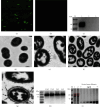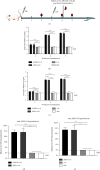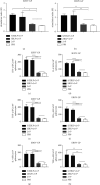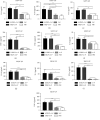A Bivalent Bacterium-like Particles-Based Vaccine Induced Potent Immune Responses against the Sudan Virus and Ebola Virus in Mice
- PMID: 40303775
- PMCID: PMC12017122
- DOI: 10.1155/2023/9248581
A Bivalent Bacterium-like Particles-Based Vaccine Induced Potent Immune Responses against the Sudan Virus and Ebola Virus in Mice
Abstract
Ebola virus disease (EVD) is an acute viral hemorrhagic fever disease causing thousands of deaths. The large Ebola outbreak in 2014-2016 posed significant threats to global public health, requiring the development of multiple medical measures for disease control. Sudan virus (SUDV) and Zaire virus (EBOV) are responsible for severe disease and occasional deadly outbreaks in West Africa and Middle Africa. This study shows that bivalent bacterium-like particles (BLPs)-based vaccine, SUDV-EBOV BLPs (S/ZBLP + 2 + P), generated by mixing SUDV-BLPs and EBOV-BLPs at a 1 : 1 ratio, is immunogenic in mice. The SUDV-EBOV BLPs induced potent immune responses against SUDV and EBOV and elicited both T-helper 1 (Th1) and T-helper 2 (Th2) immune responses. The results indicated that SUDV-EBOV BLPs-based vaccine has the potential to be a promising candidate against SUDV and EBOV infections and provide a strategy to develop universal vaccines for EVD.
Copyright © 2023 Shengnan Xu et al.
Conflict of interest statement
The authors declare that they have no conflicts of interest.
Figures







Similar articles
-
Distinct Immunogenicity and Efficacy of Poxvirus-Based Vaccine Candidates against Ebola Virus Expressing GP and VP40 Proteins.J Virol. 2018 May 14;92(11):e00363-18. doi: 10.1128/JVI.00363-18. Print 2018 Jun 1. J Virol. 2018. PMID: 29514907 Free PMC article.
-
A Bivalent, Spherical Virus-Like Particle Vaccine Enhances Breadth of Immune Responses against Pathogenic Ebola Viruses in Rhesus Macaques.J Virol. 2020 Apr 16;94(9):e01884-19. doi: 10.1128/JVI.01884-19. Print 2020 Apr 16. J Virol. 2020. PMID: 32075939 Free PMC article.
-
Recombinant Protein Filovirus Vaccines Protect Cynomolgus Macaques From Ebola, Sudan, and Marburg Viruses.Front Immunol. 2021 Aug 18;12:703986. doi: 10.3389/fimmu.2021.703986. eCollection 2021. Front Immunol. 2021. PMID: 34484200 Free PMC article.
-
Advances in Designing and Developing Vaccines, Drugs, and Therapies to Counter Ebola Virus.Front Immunol. 2018 Aug 10;9:1803. doi: 10.3389/fimmu.2018.01803. eCollection 2018. Front Immunol. 2018. PMID: 30147687 Free PMC article. Review.
-
Recent advances in the development of vaccines for Ebola virus disease.Virus Res. 2016 Jan 4;211:174-85. doi: 10.1016/j.virusres.2015.10.021. Epub 2015 Oct 24. Virus Res. 2016. PMID: 26596227 Review.
References
-
- Centers for Disease Control and Prevention. Ebola(Eboal virus disease) 1976. https://www.cdc.gov/vhf/ebola/history/distribution-map.html .
MeSH terms
Substances
LinkOut - more resources
Full Text Sources
Medical

